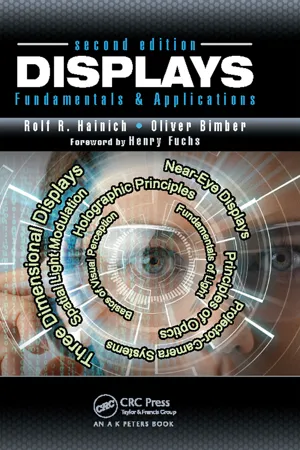Physics
Focal Points
Focal points are specific points in space where light rays converge or from which they appear to diverge after passing through a lens or reflecting from a curved mirror. In the context of physics, these points are crucial for understanding the behavior of light and the formation of images in optical systems. Understanding focal points is essential for various applications, including photography, microscopy, and astronomy.
Written by Perlego with AI-assistance
Related key terms
Related key terms
1 of 4
Related key terms
1 of 3
7 Key excerpts on "Focal Points"
- eBook - ePub
- Britannica Educational Publishing, Erik Gregersen(Authors)
- 2010(Publication Date)
- Britannica Educational Publishing(Publisher)
Optics had progressed rapidly by the early years of the 19th century. Lenses of moderately good quality were being made for telescopes and microscopes, and in 1841 the great mathematician Carl Friedrich Gauss published his classical book on geometrical optics. In it he expounded the concept of the focal length and cardinal points of a lens system and developed formulas for calculating the position and size of the image formed by a lens of given focal length. Between 1852 and 1856 Gauss’s theory was extended to the calculation of the five principal aberrations of a lens, thus laying the foundation for the formal procedures of lens design that were used for the next 100 years. Since about 1960, however, lens design has been almost entirely computerized, and the old methods of designing lenses by hand on a desk calculator are rapidly disappearing.By the end of the 19th century numerous other workers had entered the field of geometrical optics, notably an English physicist, Lord Rayleigh (John William Strutt), and a German physicist, Ernst Karl Abbe. It is impossible to list all their accomplishments here. Since 1940 there has been a great resurgence in optics on the basis of information and communication theory.LIGHT RAYS , WAVES, AND WAVELETSA single point of light, which may be a point in an extended object, emits light in the form of a continually expanding train of waves, spherical in shape and centred about the point of light. It is, however, often much more convenient to regard an object point as emitting fans of rays, the rays being straight lines everywhere perpendicular to the waves. When the light beam is refracted by a lens or reflected by a mirror, the curvature of the waves is changed, and the angular divergence of the ray bundle is similarly changed in such a way that the rays remain everywhere perpendicular to the waves. When aberrations are present, a convergent ray bundle does not shrink to a perfect point, and the emerging waves are then not truly spherical. - eBook - ePub
Laser Safety
Tools and Training, Second Edition
- Ken Barat(Author)
- 2017(Publication Date)
- CRC Press(Publisher)
They fan out from the focal point just as the rays fan out from a point source. They are not traveling in all directions, though, because the lens only collected a limited number of the rays from the source. However, for an observer in the path of those rays the rays are just as if the point source were located at the focal point. Recall that the brain interprets vision based only on the light that enters the eye, so the perception is exactly as if the point source were located at the focal point. Therefore, we call the focal point the image of the point source at infinity (i.e., at a very large distance). The ability to essentially take an object at one location and transform it into an image at another location is very useful and is the basis for many optical instruments, such as telescopes, microscopes, and cameras. It is at this point that a traditional optics tutorial begins to get quite complex with numerous cases derived from different curvatures, different object locations, and multielement optical systems. The specialized terminology alone can be daunting to the uninitiated. Fortunately for the readers of this chapter, there is not enough space to go into all of this. However, a few more concepts are needed to treat issues arising in the context of laser safety. The first is that of imaging of an extended object rather than a point source and not necessarily at a large distance. Then, I briefly return to the wave nature of light to discuss the role of diffraction in imaging. Finally, I mention negative lenses and virtual images. In Figure 6.12, the same lens discussed for Figure 6.11 is shown. The object is an extended object. The object can be anything; for example, it could be the candle discussed in the preceding section. For purposes of illustration, the object is just represented as an arrow. The object is not at a large distance from the lens. The effect of the lens on the rays is found by considering each point on the object as a point source - eBook - ePub
Seeing the Light
Optics in Nature, Photography, Color, Vision, and Holography (Updated Edition)
- Joan G. Thomas, David Falk, Dieter Drill, David Stork(Authors)
- 2018(Publication Date)
- Echo Point Books & Media(Publisher)
Fig. 3.22 ). Focusing lenses are quite old. The early ones were glass spheres filled with water. The Greek comic playwright Aristophanes suggested that burning glasses could be used to annul promissory notes by melting the letters off the wax notes.FIGURE 3.21A converging lens, consisting of two converging surfaces. (a) Rays parallel to the axis are focused at F′. (b) Rays originating at F are also made to converge and emerge parallel to the axis.A converging lens also has a first focal point, F, in front of the lens (Fig. 3.21b ). All rays originating at F and passing through the lens will emerge parallel to the axis. To see that this must be true, notice that Figure 3.21b is simply Figure 3.21a flipped around, with the arrows on the rays reversed.We can make a diverging lens by combining the two diverging surfaces of Figures 3.20c and d . In Figure 3.23a , we see that the incident rays parallel to the axis are made to diverge. To an eye on the right- hand side of the lens, these divergent rays will appear to be coming from their point of intersection (when extended backward). We again label this point F′ and call it the second focal point. For the diverging lens, then, F′ lies in front of the lens (the reverse of a converging lens, where parallel incident rays actually go through F′).FIGURE 3.22Flipping Figure 3.23a over and reversing the arrows (Fig. 3.23b ) shows that the first focal point, F, of a diverging lens lies behind the lens. All rays aimed at F that hit the lens emerge parallel to the axis.FIGURE 3.23A diverging lens, consisting of two diverging surfaces. (a) Rays parallel to the axis seem to come from F′ after they pass through the lens. (b) Rays converging toward F - eBook - ePub
Let There Be Light
The Story of Light from Atoms to Galaxies
- Ann Breslin, Alex Montwill(Authors)
- 2013(Publication Date)
- ICP(Publisher)
f which applies to either side of the lens.Principal rays (thin lenses)We can also draw rays which pass through certain selected points for lenses, as we did for mirrors. There are just three such rays.Ray (1) enters parallel to the optic axis, and passes through the focus on the other side.Principal rays passing through a convex lens.Ray (2) strikes the centre of the lens, and passes through without deviation.Ray (3) passes through the focus, on its way to the lens, and exits parallel to the axis on the other.The lens equationThe object distance and image distance are related to the focal length of the lens:Magnification is related to the ratio υ/u and can be defined in such a manner as to indicate the orientation of the image. In our convention we define magnification as m = -υ/u.*SymmetryThe lens equation exhibits symmetry between the object distance and the image distance. The relation would be just as valid if object and image were interchanged. In the extreme case of the object at infinity, the image is at the focus; placing the object at the focus will give an image at infinity, i.e. a parallel outgoing beam. We cannot place the object further away than at infinity, therefore the image of a real object is never closer to the lens than the focal distance.Breaking the symmetryWe can now raise an interesting question relating to symmetry. The image is never closer than the focal point of the lens.* Notice that when the ratio υ/u is positive, the image is upright, and when it is negative, the image is inverted.We have just stated that image and object may be interchanged, and the relation remains valid. But there is nothing to stop us from placing the object inside the focus! - eBook - ePub
Displays
Fundamentals & Applications, Second Edition
- Rolf R. Hainich, Oliver Bimber(Authors)
- 2016(Publication Date)
- A K Peters/CRC Press(Publisher)
front focal plane. Thus, parallel rays on one side of the lens are mapped to the focal point on the other side. Nonparallel rays (i.e., belonging to object or image points that are closer than infinity) do not map to the focal point. But light rays that cross these points from the same angle always cross on the opposite focal plane.The focal length of a spherical lens can be computed as:1 f= (η 2− 1 )(+)1−r 11r 2(2η 2− 1 )η 2tr 1r 2(3.23) where r1 and r2 are the two radii, and t is the central thickness.The behavior of converging lenses is similar to the behavior of concave mirrors, but reversed. 3.4.2.3 Diverging LensesWith diverging lenses, objects at infinity create virtual images at the focal plane (Figure 3.19 (right)). Real objects always create virtual images, independent of their location.The behavior of diverging lenses is similar to the behavior of convex mirrors, but reversed. 3.4.2.4 Plane Parallel and Curved Parallel LensesObjects behind a thick glass plate appear slightly enlarged because of refraction, an effect that is increased if the glass is curved toward the observer. This fact is important for the design of cathode ray tubes with their very thick front panels.3.4.2.5 Varifocal LensesVarifocal in this context does not address zoom lenses for photographic equipment, which are built of several complex (rigid) lens groups that are moved forward and backward to change focal length. Instead, varifocal lenses are lenses that can change their surface shape. This is more difficult to achieve than with mirrors, and is usually confined to very small lenses. They are also sometimes referred to as liquid lenses.Varifocal microlenses can, for example, be built by enclosing a conducting aqueous solution (e.g., a salt solution) and a nonconductive oil (e.g., silicon oil) in a small cavity. Surface tension and a hydrophobic wall coating cause the intersection between the fluids to be curved and to work as a lens because of the different refraction indices of the two liquids (Figure 3.22 ). By applying voltage, electrostatic force changes the intersection curvature [260 - eBook - ePub
Cinematography: Theory and Practice
Image Making for Cinematographers and Directors
- Blain Brown(Author)
- 2016(Publication Date)
- Routledge(Publisher)
Figure 14.1. Lenses and the language of the lens play a key role in Hitchcock’s Rear Window.optics & focus
Figure 14.2. An Arri Alura 18mm to 80mm zoom lens on a Canon C-300. (Photo courtesy Niche Cameras, New Zealand).THE PHYSICAL BASIS OF OPTICS
Except for certain minor differences, the principles of optics and the use of lenses are the same for film and video. Nearly all principles of optics and optical design are based on a few properties of physics. The two most basic are reflection and refraction. There are a few things we need to know about the basic behavior of light in order to understand the fundamentals of optics.REFRACTION
The refraction of visible light is an important characteristic of lenses that allows them to focus a beam of light onto a single point. Refraction, or bending of the light, occurs as light passes from one medium to another when there is a difference in the index of refraction between the two materials. Refractive index is defined as the relative speed at which light moves through a material with respect to its speed in a vacuum. When light passes from a less dense medium such as air to a more dense medium, such as glass, the speed of the wave decreases. Conversely, when light passes from a more dense medium to a less dense medium, the speed of the wave increases. The angle of refracted light is dependent upon both the angle of incidence and the composition of the material into which it is entering. “Normal” is defined as a line perpendicular to the boundary between two substances.FOCAL LENGTH AND ANGLE OF VIEW
The focal length of the lens is the distance between the optical center of the lens and the image sensor when the subject is in focus; it is usually stated in millimeters such as 18 mm, 50 mm, or 100 mm (Figure 14.3 ). For zoom lenses, both the minimum and maximum focal lengths are stated, for example, 18—80 mm (Figure 14.2 - eBook - ePub
- Galen C. Duree(Author)
- 2011(Publication Date)
- For Dummies(Publisher)
or making images (see Part II). In this theory, the particles of light follow straight-line paths from the source to the next surface. This idea leads to the simplest type of imaging: shadows. Shadows don’t give you a lot of information, but you can still tell the shape of the object as well as where the light source is.Two important concepts in geometrical optics are reflection and refraction. Reflection describes light bouncing off a surface. RefractionHarnessing interference and diffraction with the wave property of lightdeals with the bending of the path of the light as the light goes from one material to another. You can use these processes to create and modify images, and knowledge of these effects can also help you deal with factors calledaberrations,which cause an image to be blurry. You can also use the lenses and mirrors that work with refraction and reflection to eliminate the washed-out effect you sometimes get when creating an image; if you have too much light, all the images created wash each other out, so all you see is light.Physical optics, which I cover in Part III, looks at the wave properties of light. Interference (where two or more waves interact with each other) and diffraction (the unusual behavior of waves to bend around an obstacle to fill the space behind it) are unique to waves.To explain optical interference (interference between light waves), you need to know about optical polarization. Optical polarizationdescribes the orientation of the plane that the light wave’s electric field oscillates in. In optics, only the electric field matters in almost all interactions with matter, because the electric field can do work on charged particles and the magnetic field can’t. Several devices can change the polarization state so that light can be used for many different applications, including lasers and optical encoding.
Index pages curate the most relevant extracts from our library of academic textbooks. They’ve been created using an in-house natural language model (NLM), each adding context and meaning to key research topics.
Explore more topic indexes
Explore more topic indexes
1 of 6
Explore more topic indexes
1 of 4






